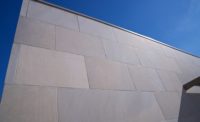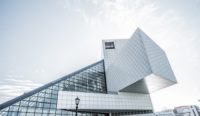Solid Metal Panels: Design Flexibility, Maximum Functionality

National Museum of the United States Army. All photos courtesy of Metalwerks.
Top-Tier Looks Without Compromising Performance
Pushing the limits of architectural design can sometimes produce drawbacks when it comes time to source the appropriate building materials. Plainly put, it can be frustrating for inspired designers to make modification to their vision because of a product’s shortcomings.
Advances in technology and more precise techniques have enabled many building materials to overcome these limitations, making them part of the solution.
That includes solid metal panels.
When it comes to aesthetic impact, versatility, and durability, the options with solid metal panels are nearly boundless.
Aesthetic
For many people, metal panels as exterior cladding conjure mental images of sleek facades with flat panels, typically stainless steel. Though that is certainly an option and a preference for some, metal panels can be specified to meet virtually any design, including custom 3D profiles.
Consider how metal panels can be customized to achieve a unique look. They can be coated in any color imaginable, and the specified coating often has the ability to deflect heat and optimize a building’s thermal efficiency.
These options were employed to a significant extent in the design and construction of the National Museum of the United States Army. More than 110,000 square feet of metal wall panels played a pivotal role in the development of the building’s façade. An engineered flat plate assembly comprised of an extruded aluminum frame with an architectural finish plate produced a look that mimicked the visual of a line of soldiers marching in formation as a unit.
The look was so striking, it garnered an award for its design.
The Finer Details
A hand-in-hand relationship between an architect and a metal panel manufacturer can pay dividends when it comes to a project’s small details. Components such as column covers, cornices, and eyebrows are where metal panels shine—sometimes literally. Being able to adapt in these areas is a massive advantage for architects who seek to mimic the look of neighboring facades, who are designing structures in historic neighborhoods, or who are leading the charge on properties that wish to take artistic license in their creations.
This adaptability was particularly impactful in the case of a joint-branded hotel in Colorado Springs, CO. The SpringHill Suites by Marriott and Element by Westin hotels had a unique aesthetic issue: They both occupy a single, shared building. A close relationship between architect and supplier was critical to ensure both brands felt represented by a single, contemporary design.
The divide between the brands was bridged thanks to careful design cues. In this instance, the hotel building incorporated three-dimensional metal paneling as accents that run the height of the building. Aesthetically, these custom elements feature striking bends, formed edges, and minimal panel gaps. In performance, the custom pieces are noncombustible, corrosion resistant, and highly protective, preventing moisture and air intrusion. All these details serve to unify the hotel’s two brands with one another and with the modern looks of the surrounding neighborhood.
Sustainability
Versatile metal panels are also a sustainable option. By their very nature, metal panel systems manufacturing is efficient and can be made with a low carbon footprint. Manufacturers like Pennsylvania-based Metalwërks work closely with designers, architects, and builders to optimize their wall systems and make the best use of the master coils in production.
During manufacturing, metal blanking and forming processes generate very little waste when properly engineered. Any waste has fiscal value and is put back into the recycling stream. This culminates in an efficient process where 99% of all manufacturing scrap is captured and properly recycled.
Even the crating that delivers the products is designed with a recycling mindset. Beyond this, metal wall systems can easily be incorporated into projects that seek LEED certification.
Facades clad with architectural metal panels can last for generations and in many cases the entire useful life of the building which is a claim few other materials can make. In the event the owner wishes to change the facade, the old materials can be removed and recycled for another use. Composites, veneers infused with plastics or foam insulated materials cannot make this claim.
Durability & Fire Protection
Metal plate cladding offers stellar peace of mind in terms of a building’s protective qualities. Beauty and aesthetics aside, plate metal panels have an incredibly high resistance to denting and puncturing. This makes them a top choice for high-traffic or abusive environments.

Consider the now-completed expansion of New York’s Grand Central Station, which utilized more than 120,000 square feet of flat and curved aluminum assemblies to line 4,600 linear feet of tunnel walls. An additional 73,000 square feet of stainless-steel cladding was used in other high-traffic areas of the station, including elevators, escalators, stair enclosures, and more.
Metalwerks supplied a specialized PVDF polyvinylidene fluoride-coated aluminum for the tunnel wall surfaces for additional protection. This addition ensures long-lasting aesthetics and performance for such a highly visible project that hosts more than a quarter of a million daily commuters.
Rainscreens also offer robust fire protection. NPFA 285 is a standard fire test method that evaluates the fire propagation characteristics of exterior wall assemblies. The test helps to assess how a façade’s materials may contribute to the spread of flame and smoke. In a project’s design, only aluminum composite and metal composite materials are tested.
Solid metal plate panels do not have composite materials and are thereby safer in a fire event. Because they lack these composites, they are exempt from NFPA 285 testing. What this means for projects is far fewer concerns about safety.
Finishing Touches
Plainly put, metal plate is one of the most versatile, longest-lasting cladding options available to designers and architects today. Too often overlooked, metal plate offers a litany of immediate and long-term benefits for projects.
But just as important as the substrate itself, so too is a supplier relationship. Seeking out a reputable manufacturer can help ensure open communication and, where available, design-assist services. All told, the investment can mean that the next project will shine for years to come.
Looking for a reprint of this article?
From high-res PDFs to custom plaques, order your copy today!





-web.jpg?height=200&t=1635342010&width=200)
